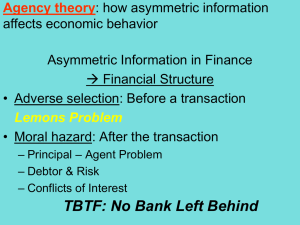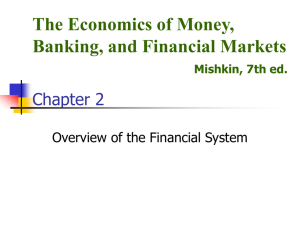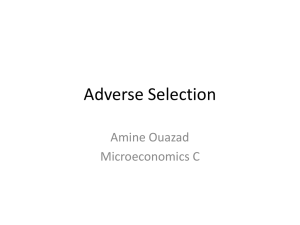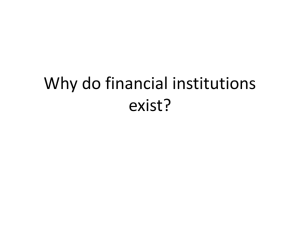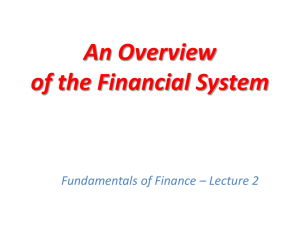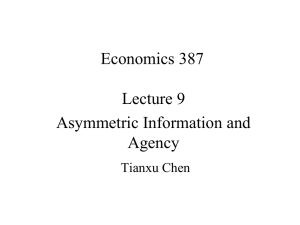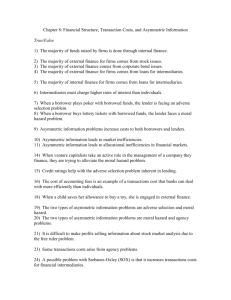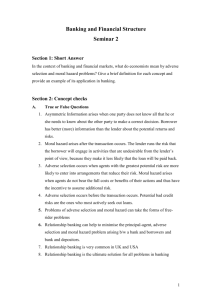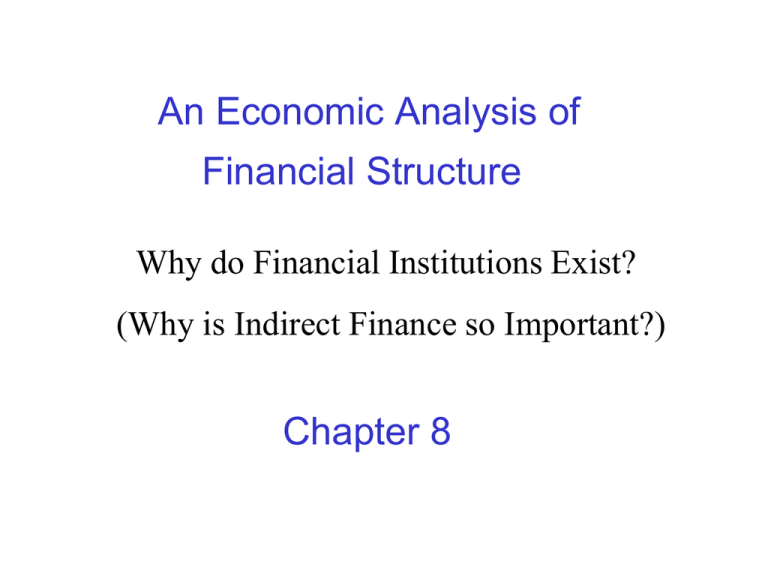
An Economic Analysis of
Financial Structure
Why do Financial Institutions Exist?
(Why is Indirect Finance so Important?)
Chapter 8
Chapter Preview
Look at why financial institutions exist and how
they promote economic efficiency.
Topics include:
• Some Basic Facts About Financial Structure
• Transaction Costs
• Asymmetric Information: Adverse Selection and
Moral Hazard
Basic Facts About Financial Structure
Throughout the World
• The chart on the next slide shows how
non-financial business get external
funding in the U.S., Germany, Japan, and
Canada.
Sources of External Finance for Nonfinancial Businesses
Copyright © 2007 Pearson Addison-Wesley. All rights reserved.
Mishkin Presents Eight Basic Facts of
Financial Structure
1. Stocks (direct finance) are not the most
important source of external financing for
businesses
2. Issuing marketable debt and equity
securities (direct finance) is not the
primary way in which businesses finance
their operations
Mishkin’s Eight Basic Facts of Financial
Structure
3. Indirect finance, which involves the
activities of financial intermediaries, is
many times more important than direct
finance, in which businesses raise funds
directly from lenders in financial markets.
4. Financial intermediaries, particularly banks,
are the most important source of external
funds used to finance businesses.
Eight Basic Facts of Financial Structure
5. The financial system is among the most
heavily regulated sectors of economy.
6. Only large, well-established corporations
have easy access to securities markets
(direct finance) to finance their activities.
Eight Basic Facts of Financial Structure
7. Collateral is a prevalent feature of debt
contracts for both households and
businesses.
8. Debt contracts are typically extremely
complicated legal documents that place
substantial restrictions on the behavior of
the borrowers.
Why is Indirect Finance so Important?
• Transactions Costs
• Information Costs
• Shades of Chapter 2
Information Costs - Asymmetric Information
• symmetric information—the case where all
parties to a transaction or contract have the
same information.
• In many situations, this is not the case.
Information is not the same. We refer to this
imbalance in information as asymmetric
information.
Asymmetric Information:
Adverse Selection and Moral Hazard
• Adverse Selection
1.
Occurs when one party in a transaction
has better information than the other party
2.
Occurs before transaction occurs
3.
In financial markets, potential borrowers
most likely to produce adverse outcome
are the ones most likely to seek loan
The Lemons Problem: How Adverse
Selection Influences Financial Structure
• If quality cannot be assessed, the buyer is willing
to pay at most a price that reflects the average
quality
• Sellers of good quality items will not want to sell at
the price for average quality
• Bad quality pushes good quality from the
market because of an information gap is
known as "adverse selection”
The Classic Example - The Lemons Problem
• Suppose that used cars come in two types:
those that are in good repair (peaches) and
bad shape (lemons). The sellers know the
quality of the cars.
• Suppose further that used-car shoppers
would be prepared to pay $20,000 for a good
one and $10,000 for a lemon.
• If buyers had the information to tell good from
bad, they could strike fair trades with the
sellers, $20,000 for good car and $10,000 for
the lemon.
Asymmetric Information - The Lemons Problem
• If buyers do not have good information and
cannot tell the quality difference, there will be
only one market for all used cars.
buyers will pay only the average price of a good car and a
lemon, or $15,000
• This is below the $20,000 that good-car
owners require; so they will exit the market,
leaving only bad cars.
• This result, when bad quality pushes good
quality from the market because of an
information gap, is known as "adverse
selection".
Adverse Selection and Financial Structure
Lemons Problem in Securities Markets
• Suppose investors cannot distinguish between
good and bad securities, willing to pay only the
average of the good and bad securities’ values.
• Result: Good securities undervalued and firms
won’t issue them; bad securities overvalued, so
too many issued.
Actions to Help Solve Adverse Selection
Problems
• Government Regulation to Increase
Information (explains Fact # 5)
Actions to Help Solve Adverse Selection
Problems
• Financial Intermediation
FIs fill the information gap
Analogy to solution to lemons problem
provided by used car dealers
FIs avoid free-rider problem. Make private
loans and keep information private (explains
Fact # 3 and # 4)
Also explains fact #6 - large firms are more
likely to use direct instead of indirect
financing
Actions to Help Solve Adverse Selection
Problems
• Collateral and Net Worth
Explains Fact # 7
• Private Production and Sale of
Information
Free-rider problem interferes with this
solution
Asymmetric Information: Adverse
Selection and Moral Hazard
• Moral Hazard
1.
Occurs when one party has an incentive to
behave differently once an agreement is
made between parties
2.
Occurs after transaction occurs
3.
For example, Hazard that borrower has
incentives to engage in undesirable (immoral)
activities making it more likely that won't pay
loan back
How Moral Hazard Affects the Choice
Between Debt and Equity Contracts
• With equity, have Principal-Agent Problem
Separation of ownership and control
of the firm
Principal (stockholder) has less information
Agent (manager) has more information
Managers pursue personal benefits and power
rather than the profitability of the firm
Actions to help solve the PrincipalAgent Problem:
• Monitoring of managers
Expensive
• Use debt rather than equity
Reduces the need to monitor as long as borrower is
performing. Explains Fact 1, why debt is used more
than equity
• Government regulation to increase information
Fact 5
• Financial Intermediation
Venture capital firms provide the equity and place
there own people in management
Moral Hazard Influence in Debt Markets
• Even with the advantages just described, debt
is still subject to moral hazard.
Debt may create an incentive to take on very risky
projects.
• Example:
suppose a firm owes $100, but only has $90? It
is essentially bankrupt. The firm “has nothing to
lose” by looking for “risky” projects to raise the
needed cash. Know as “Gambling for
Resurrection”.
Lenders need to find ways ensure that
borrower’s do not take on too much risk.
A good legal contract
Bonds and loans often carry restrictive
covenants
• Restrict how funds are used
Require minimum net worth, collateral, bank
balance, credit rating.
• Financial Intermediaries have special advantages
in monitoring[Facts 3 and 4]
STOP HERE!!


